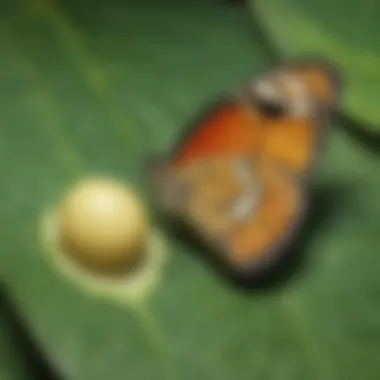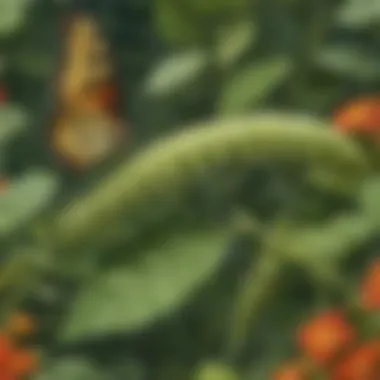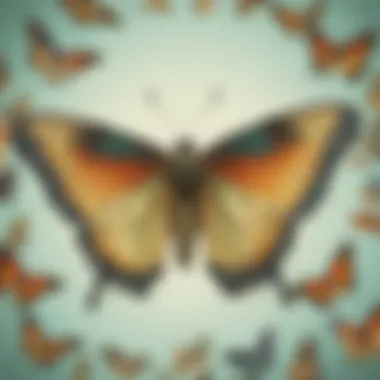Unveiling the Enchanting Stages of Butterfly Transformation


[This article delves into the captivating journey of a butterfly's transformation, exploring the intricate stages from egg to adult butterfly. Discover the remarkable process of metamorphosis and gain a deeper understanding of the beauty and complexity behind these delicate creatures.]
Interactive Learning Games
Butterflies undergo a remarkable transformation in stages that are as captivating as they are intricate. From the humble beginnings of an egg, they embark on a journey of metamorphosis that culminates in the emergence of a stunning adult butterfly. Understanding these stages not only unveils the beauty of nature but also provides insights into the extraordinary process of metamorphosis.
Educational Topics
The metamorphosis of a butterfly offers a unique opportunity to delve into interdisciplinary learning. By exploring subjects like biology, ecology, and even art through the lens of these magnificent insects, we can foster a holistic understanding of the natural world. Engaging with educational topics related to butterflies can significantly enhance children's curiosity and knowledge across various fields.
Step-by-Step Guides
Detailed observations of each stage, from egg to caterpillar to chrysalis and finally to butterfly, allow for a hands-on approach to learning about metamorphosis. By providing step-by-step instructions on how to observe, care for, and document the transformation of a butterfly, we offer children a tangible and immersive experience that encourages cognitive and motor skill development.
Craft Ideas
Utilizing simple household items, children can engage in creative craft projects that mirror the metamorphic journey of a butterfly. By emphasizing artistic expression through these activities, we not only nurture children's creativity but also instill a deeper appreciation for the beauty of change and transformation in the natural world.


Introduction
In this article, we embark on a comprehensive exploration of the enthralling evolution of a butterfly, shedding light on each phase with a keen eye for detail. From the initial moments of egg formation to the remarkable sight of an adult butterfly taking its first flight, we dissect critical aspects of this transformation. By understanding the nuances of each stage, we gain profound insights into the marvels of nature and the inherent resilience of these creatures.
Through a blend of scientific analysis and anecdotal observations, we emphasize the significance of each stage in shaping the life of a butterfly. By uncovering the hidden wonders of metamorphosis, we aim to inspire awe and appreciation for the delicate balance of nature's intricate design. Join us on this enlightening journey through the captivating stages of butterfly transformation, where every moment is steeped in discovery and wonder.
Egg Stage
Butterflies' incredible transformation begins at the Egg Stage, a pivotal phase where the journey to becoming a splendid butterfly commences. Understanding the Egg Stage is crucial as it sets the foundation for the entire metamorphosis process, detailing the initial creation of life within a tiny, delicate structure. These eggs hold the promise of a new life, embodying the awe-inspiring concept of birth and evolution in its purest form. The Egg Stage is where the magic of transformation truly begins, symbolizing hope, growth, and the wonders of nature.
Egg Formation
The process of Egg Formation is a marvel of nature, showcasing the intricate biological mechanisms behind the creation of these minuscule yet mighty vessels of life. It involves a series of precise steps where a female butterfly deposits eggs on specific host plants, ensuring the survival and development of the future caterpillars. The formation of these eggs is a meticulous and strategic process, guided by nature's wisdom to guarantee the continuity of the butterfly species. Each egg is a work of art, carefully crafted to protect and nourish the life growing inside, signaling the beginning of a remarkable journey.
Egg Characteristics
Exploring the Egg Characteristics reveals a world of diversity and adaptability within butterfly species. These eggs come in various shapes, sizes, and colors, each unique to the species and their environmental requirements. From tiny, spherical eggs to elongated ones, nature has designed a range of protective casings to shield the delicate life within. The characteristics of butterfly eggs play a vital role in ensuring the survival and success of the species, with adaptations that cater to different habitats and predators. Studying these characteristics provides insights into the evolutionary strategies and resilience of butterflies in the face of challenges, highlighting the ingenuity of nature's creations.
Larva Stage


The Larva Stage is a pivotal phase in the mesmerizing journey of a butterfly's transformation. This stage, also known as the caterpillar stage, plays a crucial role in the metamorphosis process, where the tiny, unassuming egg hatches into a voracious caterpillar. The Larva Stage is vital as it marks the beginning of the physical transformation that will eventually lead to the emergence of a beautiful butterfly. Understanding the Larva Stage sheds light on the intricate process of metamorphosis, showcasing the astonishing changes that occur within the cocoon.
Hatching from the Egg
One of the most remarkable moments in the butterfly's life cycle is the hatching of the egg. After an incubation period, the egg cracks open, revealing the delicate caterpillar within. The process of hatching is a delicate and crucial step in the butterfly's development, marking the transition from one stage to the next. The emergence of the tiny caterpillar signifies the beginning of its feeding phase and sets the stage for its growth and transformation.
Caterpillar Feeding Habits
During the Larva Stage, the caterpillar's feeding habits are voracious and essential for its growth. The caterpillar feeds on leaves, devouring them with impressive speed to fuel its rapid development. This phase is critical as the caterpillar consumes nutrients that will enable it to transition to the next stage of metamorphosis. Understanding the caterpillar's feeding habits provides insights into its nutritional needs and the significance of this stage in the butterfly's lifecycle.
Growth and Molting
As the caterpillar feeds and grows, it undergoes several molting stages where it sheds its outer skin to accommodate its increasing size. The process of molting is a sign of growth and development, allowing the caterpillar to expand and thrive within its environment. Each molting phase signifies progress in the butterfly's transformation journey, highlighting the continual changes taking place within the Larva Stage. Observing the growth and molting process offers a glimpse into the remarkable adaptability and resilience of these fascinating creatures.
Pupa Stage
The Pupa Stage is a critical phase in the mesmerizing transformation process of a butterfly. This stage marks the moment when the caterpillar suspends itself from a twig or leaf and starts to undergo a remarkable metamorphosis. Understanding the intricacies of the Pupa Stage provides valuable insights into the miraculous journey of a butterfly. Throughout this stage, significant changes occur within the chrysalis that ultimately lead to the emergence of a beautiful adult butterfly.
Formation of Chrysalis


During the Formation of Chrysalis, the caterpillar transforms into a pupa by shedding its last caterpillar skin and revealing the chrysalis beneath. This phase is characterized by the pupa secreting a silk thread to attach itself securely to a suitable surface. The chrysalis, resembling a jade jewel adorned with intricate gold patterns, encases the developing butterfly within, offering protection and allowing for undisturbed metamorphosis to take place.
Metamorphosis Inside the Pupa
Metamorphosis Inside the Pupa is a period of intense transformation where the caterpillar's body breaks down into individual cells known as imaginal discs. These discs contain the genetic information necessary to form the complex structures of the adult butterfly. Within the chrysalis, these cells rapidly multiply and develop, reshaping the insect entirely. The metamorphosis process is a testament to nature's precision and the astonishing ability of a humble caterpillar to emerge as a magnificent butterfly.
Emergence of Butterfly
The Emergence of the Butterfly from the chrysalis symbolizes the culmination of the intricate metamorphosis journey. As the adult butterfly emerges, wet and crumpled wings gradually unfurl to reveal vibrant colors and delicate patterns. This awe-inspiring moment signifies the successful completion of the transformation from a humble egg to a magnificent winged creature. The emergence of the butterfly is a testament to the beauty and resilience woven into the fabric of nature, showcasing the unparalleled wonders of the natural world.
Adult Butterfly Stage
Butterfly transformation is incomplete without reaching the Adult Butterfly Stage. This pivotal phase marks the culmination of a mesmerizing journey from egg to a fully formed butterfly. The Adult Butterfly Stage is a moment of revelation, where the true majesty of these creatures unfolds. It serves as a testament to the miracle of metamorphosis and the resilience of nature. Understanding this stage is crucial to appreciating the intricate process of butterfly development. Each step in this stage holds significance, contributing to the final emergence of a magnificent butterfly.
Wings Expansion and Drying
In the Wings Expansion and Drying phase, the butterfly undergoes a remarkable transformation that is vital for its survival. Once the butterfly emerges from the chrysalis, its wings are deflated and damp, rendering it incapable of flight. To enable flight, the wings need to expand and dry properly. This process is intricate and crucial, as the wings' delicate structure must unfold correctly to ensure the butterfly's ability to fly effortlessly. The expansion of the wings allows for the intricate patterns and vibrant colors to fully develop, enhancing the butterfly's beauty and aiding in camouflaging from predators. Drying of the wings is equally essential, as moisture can weigh down the wings, hindering flight. Patience is key during this phase, as the butterfly waits for its wings to dry completely, symbolizing a moment of profound transformation and readiness for flight.
First Flight
The First Flight is a momentous occasion in a butterfly's life, symbolizing freedom, strength, and adaptability. As the butterfly takes to the air for the first time, it embarks on a journey of discovery and exploration. Flight is not merely a means of transportation for the butterfly but a symbol of independence and endurance. The first flight signifies the successful completion of the transformation process and the beginning of a new chapter in the butterfly's life. It is during this inaugural flight that the butterfly hones its flying skills, learns to navigate its environment, and seeks out sources of nourishment. The first flight is a testament to the butterfly's resilience and adaptability, highlighting its ability to thrive in diverse habitats and conditions.
Butterfly Feeding Habits
Butterfly Feeding Habits play a crucial role in the butterfly's survival and reproductive success. As delicate creatures, butterflies rely on specific feeding strategies to obtain essential nutrients for energy and reproduction. Their feeding habits are intrinsically linked to their role in pollination, making them vital contributors to ecosystem health. Butterflies have evolved specialized mouthparts to suit their feeding preferences, whether it's sipping nectar from flowers or consuming other sources of nutrition. Understanding the intricacies of butterfly feeding habits sheds light on their ecological importance and highlights the interdependence between butterflies and flowering plants. By exploring their feeding behaviors, we gain a deeper appreciation for the vital role butterflies play in maintaining the balance of natural ecosystems.















